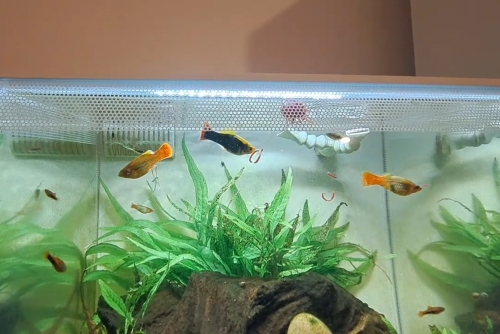In this post, will be talking about one of the stable, easy to find and popular fish food for aquarium hobbyist to feed their pet fish, called the Bloodworms.
We will be looking into this live or frozen fish food delight life cycle, distribution, benefits and consequence using this fish food.
There are already quite many suggesting there are dangers feeding this food to some number of species of fish in the hobby.
At the end this post, I hope you find good information and you be the judge if bloodworms are one of the best food for your fish.
What are Bloodworms?
When I first have known this and despite the word “worm” as part of its name. For sure it will would also be a shock for you as newbie in the hobby. If I told you that bloodworms we use as food to feed ornamental fish are not really worms. But are aquatic larvae of a small flying insect called the midge fly.
Bloodworms are not like tubifex worms, white worms and grindal worms that are actually worms. They more resemble the larva stage of a mosquito which is another high protein fish food that tropical fishes loves to eat.
Where Do Bloodworms Live and Life Cycle?
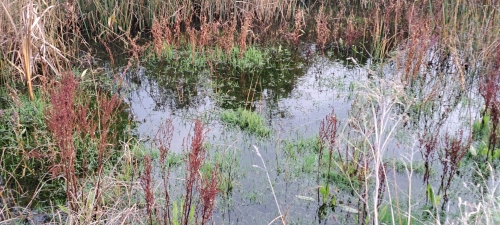
Fresh water pond are perfect habitat for bloodworms
After the midge fly mating. The female midge fly will then search and find a place to lays its eggs.
There can be a number of places and a midge fly is not picky on where to lay its eggs.
Most likely places are ponds, marshes, muddy puddles, still water, moist wet decaying organic matter, polluted sewage water and even on dirty waste water collecting on poultry farms containing animal manures.
The life cycle of a bloodworm is again like of a mosquito larvae. Bloodworm is the 2nd stage of the four stages of life cycle of a midge fly.
Midge Fly Life Cycle: <1st Egg Stage> – <2nd Bloodworm: Larvae Stage> – <3rd Pupae Stage> – <4th Adult Midge Fly>
On a nutshell, bloodworms are hardy creatures, or a stage on a midge fly’s life cycle that can live without any qualms on polluted low oxygenated water. Eating only detritus, algae and tiny organic matter particles in order for it to thrive and survive.
Are Bloodworms Harmful to Fish and Do They Contain Parasites?
Searching into the internet, watching Youtube videos and looking into Facebook groups to find vital information. I found out there are many contrasting ideas and aquarist different beliefs regarding feeding fish with bloodworms.
Some says bloodworms are safe and others says are not safe, or can be dangerous to feed to your fish with very little nutrients.
Especially they said on dwarf cichlids, rams and discus because of the hard and rough carapace (hard upper shell on the bloodworms).
They said these type of species of aquarium fish are having problems and difficulties digesting bloodworms.
Moreover, there are speculation that bloodworms might contain parasites and harmful bacteria to fish because on where it lives and are found.
I think as long as you buy your aquarium food products on trusted brands in the hobby, and it says in the pack that the bloodworms are “Gamma Irradiated”.
You can be rest assured, the product will be pathogen free.
Proper Time and How Often Should You Feed Your Fish
In general, you can feed your fish at least once a day or twice a day in smaller portion. This is to ensure no food is wasted and to prevent uneaten food in becoming debris that can polute the water quality and change the tank parameters.
But if you want a more specific answer, and spot on the best way on how to feed your fish. Is by doing your research early on before buying the fish you like and establishing a tank for that species of fish.
You should think right from the beginning of the hobby that not all fish feed the same way, or on a daily basis. In some species of fish. Skipping meals or fasting a day or two, or even a for week is beneficial. This is especially for predatory fish.
For small schooling fish, nano fish and fries with small stomach. A meal a day is sufficient, or feeding these type of fish every other day is okay if your worried of over feeding them.
Make sure too that you feed your fish when they are most active. Their are fish that are active in daytime, while others are at night time.
Daytime fish will eat well when there is proper light and nocturnal fish will eat at night when the aquarium light are turned off in total darkness.
Bloodworm Ingredients, Storage and Nutrition
My son and I are feeding our fish with frozen bloodworms. Up to now, I never seen yet live bloodworms for sale to try in feeding our fish.
This is the frozen bloodworm brand we buy to feed our platies. I am satisfied on the quality of this product.
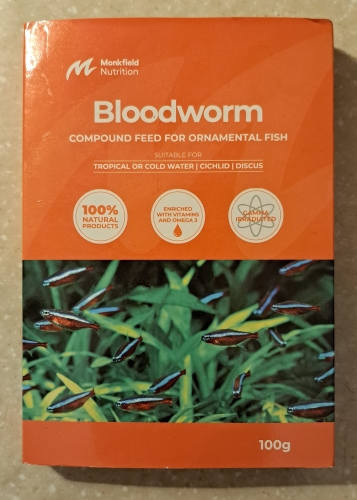
Front Label:
- Brand: MonkField Nutrition Bloodworm
- BLOODWORM
- COMPOUND FEED FOR ORNAMENTAL FISH
- SUITABLE FOR COLD OR TROPICAL | CICHLID | DISCUS
- 100% NATURAL PRODUCTS
- ENRICHED WITH VITAMINS AND OMEGA 3
- GAMMA IRRADIATED
- 100g
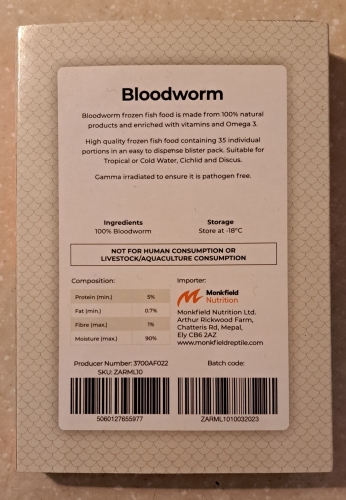
Back Label:
- Bloodworm
- Bloodworm frozen fish food is made 100% natural products and enriched with vitamins and Omega 3.
- High quality frozen fish food containing 35 individual portions in an easy to dispense blister pack. Suitable for Tropical or Cold Water, Cichlid and Discus.
- Gamma irradiated to ensure it is pathogen free.
- Ingredients 100% Bloodworm
- Storage Store at -18°C
- NOT FOR HUMAN CONSUMPTION OR LIVESTOCK/AQUACULTURE CONSUMPTION
- Producer Number: 3700AF022
- SKU: ZARML10
- Importer: Monkfield Nutrition Ltd. Arthur Richwood Farm, Chatteris Rd, Mepal, EB CB6 2AZ www.monkfieldreptile.com
Composition:
| Protein (min) | 5% |
| Fat (min) | 0.7% |
| Fibre (max) | 1% |
| Moisture (max) | 90% |
Frozen Bloodworms vs. Frozen Tubifex Worms, Which is Better?
Bloodworms offer “some nutritional value” as fish food.
5% protein with 0.7% fat, 1% fibre and moisture is at 90%. Suggesting it has lots of liquid to help keep fish hydrated. Fish needs to drink and intake of water too. Right?
Here is a comparison of nutritional information of frozen bloodworms to frozen tubifex worms. There is not much difference on nutrient values in the frozen category. You can as well compare these 2 different brands.
Monkfield Nutrition Ltd.
| Frozen Bloodworms | Frozen Tubifex Worms |
| Protein (min) 5% | Protein (min) 6% |
| Fat (min) 0.7% | Fat (min) 2% |
| Fibre (max) 1% | Fibre (max) 0.6% |
| Moisture (max) 90% | Moisture (max) 90% |
Hikari
| Frozen Bloodworms | Frozen Tubifex Worms |
| Crude Protein min. 3.5% | Crude Protein min. 3% |
| Crude Fat min. 0.3% | Crude Fat min. 0.5% |
| Crude Fiber max. 0.7% | Crude Fiber max. 0.5% |
| Moisture max. 94.5% | Moisture max. 93% |
| Phosphorous min. 0.01% | Phosphorous 0.01 min. % |
| Vitamin C min. 10 mg/kg | Vitamin C min. 10b mg/kg |
| Vitamin B2 min. 2 mg/kg | Vitamin B2 min. 2 mg/kg |
| Vitamin B12 min. 200 µg/kg | Vitamin B12 min. 200 µg/kg |
Difference of Feeding Small Fish to Bigger Fish
For small to medium size aquarium fish, bloodworms are at the right size and small enough to pass to through their mouth and into their stomach. But for fries, bloodworms can still be too big, hard to digest and you might want to feed them with brine shrimps, or small grindal worms.
Adult nano fish has small stomach to easily fill and bigger fish need to feed more bloodworms for them to fill their larger stomach.
Another thing to consider is the fish size when feeding with bloodworms.
Feeding Different Type Fish Food
I usually alternate feed my platies with bloodworms and fish flakes. There are also a few days that I don’t feed them at all. The platies will just graze for food scraps and algae on no feeding days.
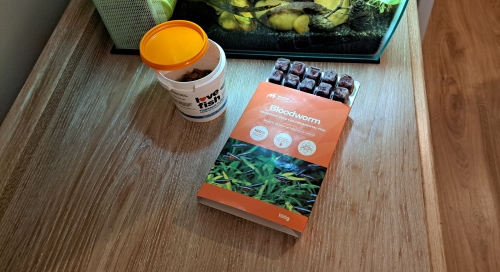
During bloodworm feeding time. You’ll notice that frozen bloodworms sinks pretty slowly.
This is good for top to middle dwelling fish to catch the food before it hits the bottom, for bottom dwelling fish to eat like the corydoras and loach.
Weekly Feeding Routine:
| Monday | Tuesday | Wednesday | Thursday | Friday | Saturday | Sunday |
| Bloodworms | Fisk Flakes | x | Fish Flakes | Bloodworms | x | x |
Final Take
Based through my few years of experience in the aquarium hobby. I haven’t encountered yet any issues feeding bloodworms for my platy fish.
Of course, I can’t speak when it comes to other species of fish if it is safe for them. Obviously for the simple reason that I haven’t tried feeding bloodworms on other fish.
My only advice is do the effort of trying to find the best quality bloodworms to buy for your fish. Don’t settle for anything less on quality and that goes the same with other fish food to feed regularly to your fish.
So I can conclude Bloodworms are safe food for fish and offer some nutrition in my opinion if bought with quality and in trusted source.
